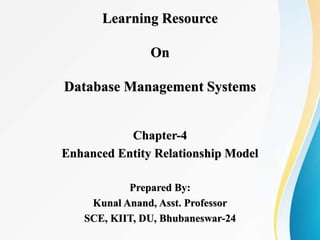
Chapter-4 Enhanced ER Model
- 1. Learning Resource On Database Management Systems Chapter-4 Enhanced Entity Relationship Model Prepared By: Kunal Anand, Asst. Professor SCE, KIIT, DU, Bhubaneswar-24
- 2. Chapter Outcome: • After the completion of this chapter, the students will be able to: – Define Enhanced Entity Relationship Model – Distinguish between super class and sub class – Distinguish between specialization and generalization – Explain aggregation and composition – Draw Enhanced ER Diagram 16 March 2021 2
- 3. Organization of this Chapter: • Introduction • Superclasses and Subclasses • Specialization and Generalization • Constraints on specialization/generalization • Aggregation and Composition • Sample example 16 March 2021 3
- 4. Enhanced ER Model • The Enhanced ER model, EER model, includes all the modeling concepts of ER model along with some additional concepts like super class and sub class, specialization, generalization, aggregation, and composition. • Super class and Sub class: – Super class is an entity type that has a relationship with one or more subtypes. On the other hand, Sub class is a group of entities with unique attributes. – Sub class inherits properties and attributes from its super class. Sub class and Super class relationship leads the concept of Inheritance. – The relationship between sub class and super class is denoted with d symbol, where d means disjointness. 16 March 2021 4
- 6. Specialization and Generalization • Specialization – The process of designating sub groupings within an entity set is called Specialization. – An entity set may be specialized by more than one distinguishing features. – ER-design, specialization is depicted by an Inverted Triangle component labeled “IS A” (is a). – Specialization can be repeatedly used to refine a ER design. 16 March 2021 6
- 8. EER Model (contd..) • Generalization: – Generalization is a simple inversion of specialization. It is the process of extracting common properties from a set of entity types and creating a generalized entity type from it. – It is a bottom-up approach in which two or more entitiy types can be generalized to a higher level entity type, if they have some attributes in common. – Specialization adopts top-down approach, while Generalization adopts bottom-up approach. – A crucial property of the higher-level and lower-level entities created by specialization and generalization is attribute inheritance. – A lower-level entity set (or subclass) also inherits participation in the relationship sets in which its higher- level entity (or superclass) participates 16 March 2021 8
- 10. Constraints on Generalization/Specialization • Membership Constraint – Condition defined • Membership of a specialization/generalization relationship can be defined as a condition in the requirements e.g. tanker is a ship where cargo = oil. – User-defined • User-defined lower-level entity sets are not constrained by a membership condition; rather, the database user assigns entities to a given entity set. • Disjoint constraints – Disjoint: • The disjoint constraint only applies when a superclass has more than one subclass. If the subclasses are disjoint, then an entity occurrence can be a member of only one of the subclasses.e.g. postgrads or undergrads; one cannot be both. • To represent a disjoint superclass/subclass relationship, Or is used. 16 March 2021 10
- 11. contd.. • Overlapping: This applies when an entity occurrence may be a member of more than one subclass, e.g. student and staff; some people are both. And is used to represent the overlapping specialization/generalization relationship in the ER diagram. 16 March 2021 11
- 12. contd.. • Completeness constraints – Total: Each superclass (higher-level entity) must belong to subclasses (lower-level entity sets), e.g. a student must be postgrad or undergrad. To represent completeness in the specialization/generalization relationship, the keyword Mandatory is used. 16 March 2021 12
- 13. contd.. • Partial: Some superclasses may not belong to subclasses (lower-level entity sets), e.g. some people at UCT are neither student nor staff. The keyword Optional is used to represent a partial specialization/generalization relationship. 16 March 2021 13
- 14. Aggregation and Composition • Aggregation: – Aggregation represents a has-a relationship between entity types, where one represents the whole and the other the part. – An example of aggregation is the Car and Engine entities. A car is made up of an engine. The car is the whole and the engine is the part. – Aggregation does not represent strong ownership. This means, a part can exist on its own without the whole. There is no stronger ownership between a car and the engine. An engine of a car can be moved to another car. – A line with a diamond at the end is used to represent aggregation.The whole must be put at the end of the diamond. 16 March 2021 14
- 15. contd.. • Composition – Composition is a form of aggregation that represents an association between entities, where there is a strong ownership between the whole and the part. – For example,: a tree and a branch have a composition relationship. A branch is 'part' of a 'whole' tree - we cannot cut the branch and add it to another tree. – A line with a filled diamond at the end is used to represent composition where the diamond side is towards the part side. 16 March 2021 15
- 16. An Example 16 March 2021 16
